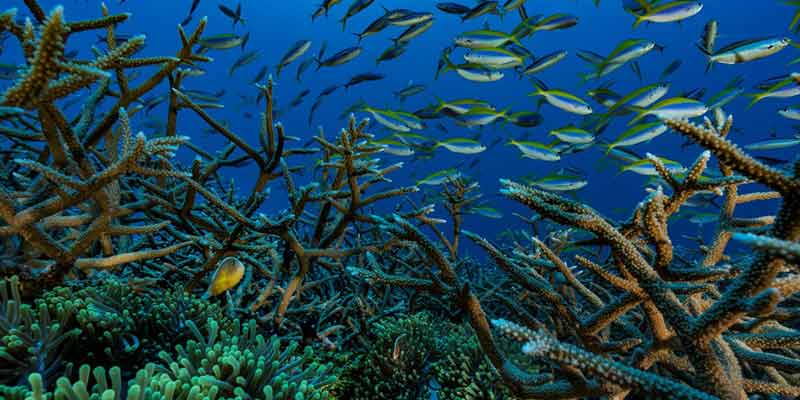- World
- Jun 20
UN adopts historic ‘High Seas Treaty’
• The UN’s 193 Member States adopted the world’s first treaty to protect the high seas and preserve marine biodiversity in international waters, marking a milestone after nearly 20 years of effort.
• The adoption followed an agreement reached in March by more than 100 countries on the text of the Biodiversity Beyond National Jurisdiction treaty, also known as the ‘High Seas Treaty’.
• The agreement will be open for signature in New York for two years starting September 20. It will take effect after 60 countries ratify the agreement.
• It will be opened for signatures on September 20, during the annual meeting of world leaders at the General Assembly, and it will take effect once it is ratified by 60 countries.
• The new treaty will allow to establish large-scale marine protected areas on the high seas, which are also necessary to meet the global commitment of the Kunming-Montreal Global Biodiversity Agreement concluded last December to protect at least 30 per cent of the ocean by 2030.
What are the high seas?
• The high seas provide invaluable ecological, economic, social and food security benefits to humanity and are in need of urgent protection.
• The high seas begin at the border of countries’ exclusive economic zones, which extend up to 200 nautical miles (370 kilometers) from coastlines. They thus fall under the jurisdiction of no country.
• Even though the high seas comprise more than 60 per cent of the world’s oceans and nearly half the planet’s surface, they have long drawn far less attention than coastal waters and a few iconic species.
• Ocean ecosystems create half the oxygen humans breathe and limit global warming by absorbing much of the carbon dioxide emitted by human activities.
• But they are threatened by climate change, pollution and overfishing.
• Only about one per cent of the high seas are currently protected.
• When the new treaty comes into force it will allow the creation of marine protected areas in these international waters.
• Although more ambitious measures will be needed, this legally-binding agreement marks an important step towards protecting the two-thirds of the ocean that lies beyond national jurisdiction.
Why the High Seas Treaty is critical for the world?
1) Fresh protection beyond borders
• While countries are responsible for the conservation and sustainable use of waterways under their national jurisdiction, the high seas now have added protection from such destructive trends as pollution and unsustainable fishing activities.
• The High Seas Treaty aims at taking stewardship of the ocean on behalf of present and future generations, in line with the Convention on the Law of the Sea.
• The new agreement contains 75 articles that aim at protecting, caring for, and ensuring the responsible use of the marine environment, maintaining the integrity of ocean ecosystems, and conserving the inherent value of marine biological diversity.
2) Cleaner oceans
• Toxic chemicals and millions of tonnes of plastic waste are flooding into coastal ecosystems, killing or injuring fish, sea turtles, seabirds, and marine mammals, and making their way into the food chain and ultimately being consumed by humans.
• More than 17 million metric tonnes of plastic entered the world’s ocean in 2021, making up 85 per cent of marine litter, and projections are expected to double or triple each year by 2040, according to the latest Sustainable Development Goals (SDG) report.
• According to UN estimates, by 2050, there could be more plastic in the sea than fish unless action is taken.
• The treaty aims at strengthening resilience and contains provisions based on the polluter-pays principle as well as mechanisms for disputes.
• Under the treaty’s provisions, parties must assess potential environmental impacts of any planned activities beyond their jurisdictions.
3) Sustainably managing fish stocks
• More than one third of global fish stocks are over-exploited. The treaty underlines the importance of capacity building and the transfer of marine technology, including the development and strengthening of institutional capacity and national regulatory frameworks or mechanisms.
• This includes increasing collaboration among regional seas organisations and regional fisheries management organisations.
4) Lowering temperatures
• Global heating is pushing ocean temperatures to new heights, fueling more frequent and intense storms, rising sea levels, and the salinisation of coastal lands and aquifers.
• Addressing these urgent concerns, the treaty offers guidance, including through an integrated approach to ocean management that builds ecosystem resilience to tackle the adverse effects of climate change and ocean acidification, and maintains and restores ecosystem integrity, including carbon cycling services.
• Treaty provisions also recognise the rights and traditional knowledge of indigenous peoples and local communities, the freedom of scientific research, and need for the fair and equitable sharing of benefits.
5) Vital for realising 2030 Agenda
• The new agreement is critical to addressing the threats facing the ocean, and to the success of ocean-related goals and targets, including the 2030 Agenda.
• Some of the goals and targets include Sustainable Development Goal (SDG) 14, which aims at, among other things, preventing and significantly reducing marine pollution of all kinds by 2025, and ending overfishing through science-based management plans in order to restore fish stocks in the shortest time feasible.
• The new agreement will enable the establishment of area-based management tools, including marine protected areas, to conserve and sustainably manage vital habitats and species in the high seas and the international seabed area.
• The treaty also considers the special circumstances facing small-island and landlocked developing nations.
Manorama Yearbook app is now available on Google Play Store and iOS App Store


